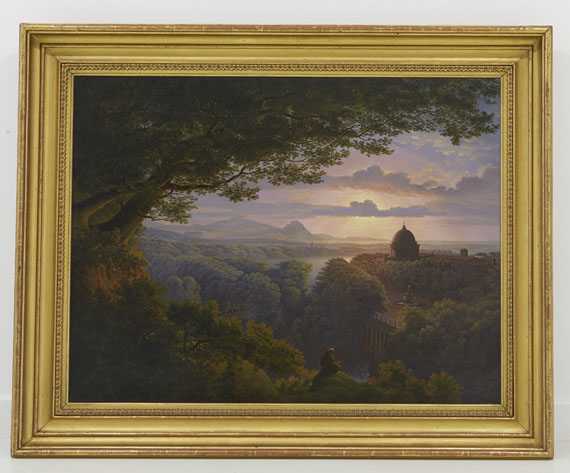131
Karl Friedrich Schinkel
Kopie nach - Landschaft mit Pilger, Um 1813.
Oil on canvas
Estimate:
€ 24,000 / $ 27,840 Sold:
€ 62,500 / $ 72,500 (incl. surcharge)
Kopie nach - Landschaft mit Pilger. Um 1813.
Oil on canvas.
79 x 105 cm (31.1 x 41.3 in). [CB].
We are grateful to Professor Dr. Helmut Börsch-Supan, Berlin, for his kind expert advice (with a writing from 21 March, 2013).
With an infrared reflectography photo executed by the Doerner-Institute, Munich, from 16 October, 2012.
PROVENANCE: Walther Heinrich-Unus, Berlin (1932).
Private ownership Northen Germany.
EXHIBITION: Deutsche Kunst im Zeitalter Goethes, Paul Cassirer, Berlin 1932, no. 211.
Karl Friedrich Schinkel. Architektur, Malerei, Kunstgewerbe, Orangerie des Schlosses Charlottenburg, Verwaltung der Staatlichen Schlösser und Gärten, Berlin 1981, no. 174, illu. in black and white p. 244 (with label indicating it as a loan on verso of frame).
LITERATURE: Ernst Riehn, Karl Friedrich Schinkel als Landschaftsmaler, dissertation (Masch.), Göttingen 1940, p. 248, notes 176.
Helmut Börsch-Supan, Bild-Erfindungen, Munich 2007, pp. 358ff.
Oil on canvas.
79 x 105 cm (31.1 x 41.3 in). [CB].
We are grateful to Professor Dr. Helmut Börsch-Supan, Berlin, for his kind expert advice (with a writing from 21 March, 2013).
With an infrared reflectography photo executed by the Doerner-Institute, Munich, from 16 October, 2012.
PROVENANCE: Walther Heinrich-Unus, Berlin (1932).
Private ownership Northen Germany.
EXHIBITION: Deutsche Kunst im Zeitalter Goethes, Paul Cassirer, Berlin 1932, no. 211.
Karl Friedrich Schinkel. Architektur, Malerei, Kunstgewerbe, Orangerie des Schlosses Charlottenburg, Verwaltung der Staatlichen Schlösser und Gärten, Berlin 1981, no. 174, illu. in black and white p. 244 (with label indicating it as a loan on verso of frame).
LITERATURE: Ernst Riehn, Karl Friedrich Schinkel als Landschaftsmaler, dissertation (Masch.), Göttingen 1940, p. 248, notes 176.
Helmut Börsch-Supan, Bild-Erfindungen, Munich 2007, pp. 358ff.
The whereabouts of Schinkel’s painting "Landschaft mit Pilger" (Landscape with Pilgrim) where already unknown in 1862 and it is still considered lost. In 1823 Wilhelm Ahlborn (1796-1857) copied five Schinkel landscapes by commission of the consul Joachim Wilhelm Wagener in Berlin, among them also the “Landschaft mit Pilger“. Today this painting is in possession of the Pushkin Museum in Moscow. In a review of the Ahlborn copy Ernst Riehn mentioned in his dissertation from 1940, that a second copy after Schinkel was in possession of the family Heinrich (-Unus) in Berlin: This work is the "Kopie 2" by an unknown painter, it was erroneously exhibited as the original Schinkel work in exhibitions at Cassirer in Berlin in 1932 and in 1981 in Charlottenburg Castle, Berlin. It was described in the catalogs as follows. “Being the only known copy of the renowned Schinkel painting, the picture [..] possesses great value.“ (Transl. from Börsch-Supan 2007, p. 361).
"The composition belongs to the Schinkel paintings that breathe the poetic spirit of early Romanticism. As it is the case with many of Friedrich’s paintings, fore- and background are strictly separated. The oak tree, rooted with little stability on the brink, spreading its branches roof-like above the ground, frames the view into a misty-eyed world, despite all yearning, it is only reachable by the eye. The monk sitting on a rock, holding a crucifix, a motif unusual for Schinkel, combines the thought of religious expectation with the fascination for nature and architecture, both are reminiscences of Italy. The domed structure is clearly reminiscent of St. Peter in Rome. [..] Schinkel’s ambitions to bring meaningful motifs in close connection – the monk, the fountain on the terrace, the cupola, the setting sun, is supported by the landscape‘s dream-like character. A reminiscence of Claude Lorrain seems intended. The painting is dated around 1813; however, due to the slightly ‘hard‘ style it is possible that it was made a little earlier [..]." Helmut Börsch-Supan, in ex. cat. Berlin 1981, pp. 242f.
"The composition belongs to the Schinkel paintings that breathe the poetic spirit of early Romanticism. As it is the case with many of Friedrich’s paintings, fore- and background are strictly separated. The oak tree, rooted with little stability on the brink, spreading its branches roof-like above the ground, frames the view into a misty-eyed world, despite all yearning, it is only reachable by the eye. The monk sitting on a rock, holding a crucifix, a motif unusual for Schinkel, combines the thought of religious expectation with the fascination for nature and architecture, both are reminiscences of Italy. The domed structure is clearly reminiscent of St. Peter in Rome. [..] Schinkel’s ambitions to bring meaningful motifs in close connection – the monk, the fountain on the terrace, the cupola, the setting sun, is supported by the landscape‘s dream-like character. A reminiscence of Claude Lorrain seems intended. The painting is dated around 1813; however, due to the slightly ‘hard‘ style it is possible that it was made a little earlier [..]." Helmut Börsch-Supan, in ex. cat. Berlin 1981, pp. 242f.
131
Karl Friedrich Schinkel
Kopie nach - Landschaft mit Pilger, Um 1813.
Oil on canvas
Estimate:
€ 24,000 / $ 27,840 Sold:
€ 62,500 / $ 72,500 (incl. surcharge)
Headquarters
Joseph-Wild-Str. 18
81829 Munich
Phone: +49 89 55 244-0
Fax: +49 89 55 244-177
info@kettererkunst.de
Louisa von Saucken / Undine Schleifer
Holstenwall 5
20355 Hamburg
Phone: +49 40 37 49 61-0
Fax: +49 40 37 49 61-66
infohamburg@kettererkunst.de
Dr. Simone Wiechers / Nane Schlage
Fasanenstr. 70
10719 Berlin
Phone: +49 30 88 67 53-63
Fax: +49 30 88 67 56-43
infoberlin@kettererkunst.de
Cordula Lichtenberg
Gertrudenstraße 24-28
50667 Cologne
Phone: +49 221 510 908-15
infokoeln@kettererkunst.de
Hessen
Rhineland-Palatinate
Miriam Heß
Phone: +49 62 21 58 80-038
Fax: +49 62 21 58 80-595
infoheidelberg@kettererkunst.de
We will inform you in time.




 Lot 131
Lot 131 
